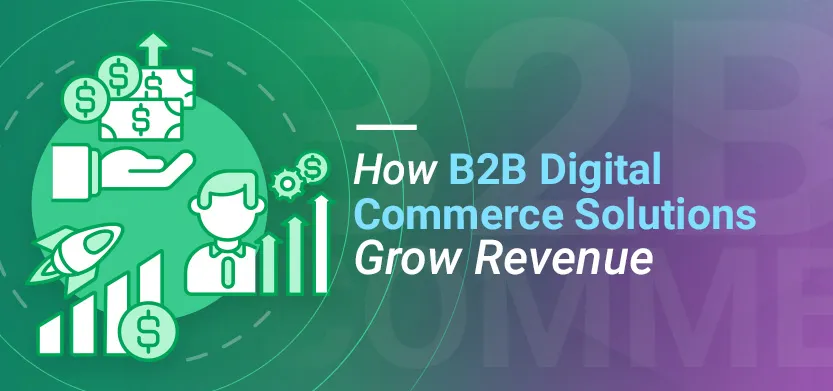
Author
Laura Meshen
, Content Marketing Specialist
Posted in Digital Commerce
May 6, 2021
How B2B digital commerce solutions grow revenue
Established B2B companies often believe they are too complex for digital commerce. The mindset can also be that it just isn’t possible to develop the right digital commerce solutions for their business. The problem is that the new B2B buyer is digitally native, an independent researcher and demanding digital commerce options from their vendors.
How digital commerce solutions grow revenue for B2B organizations
The hesitation to digitally transform traditional B2B businesses can be fueled by a misconception that going digital is too difficult. Whether it’s product type, fulfillment process, sales cycle, or existing technology, the common line being towed is that these areas are too complex and intricate to digitize.
That little white lie is often the biggest hurdle to getting buy-in from stakeholders. And in the end, the B2B buyers that are demanding digital commerce options will go elsewhere if their needs aren’t met. Without a digital commerce offering, B2B sellers risk being left behind as competitor offerings provide easy opportunities for buyers to shift their allegiance and purchasing power. Not only that, they are missing out on the opportunity to increase revenue through digital transformation.
“By 2023, B2B organizations with digital commerce offerings will see 30% more revenue.” — Gartner, The Future of Sales in 2025: A Gartner Trend Insight Report
The key to resetting change-resistant B2B stakeholder’s minds is to make the benefits of digital commerce clear. Frequently, B2B companies only look at the benefit of digital commerce solutions from an automation and cost optimization point of view. They don't realize that these solutions also have the ability to create new revenue.
How digital commerce solutions grow revenue for B2B organizations
Increased order values
 One of the biggest advantages of digital solutions for B2B commerce is the ability to use your customer data to hone and personalize the sales process for clients. Personalization tactics can be used to display relevant products, promote upsell opportunities or engage cross-sell strategies based on user history and expressed interests. By employing this kind of personalization, vendors often see increased order values and improved revenue.
One of the biggest advantages of digital solutions for B2B commerce is the ability to use your customer data to hone and personalize the sales process for clients. Personalization tactics can be used to display relevant products, promote upsell opportunities or engage cross-sell strategies based on user history and expressed interests. By employing this kind of personalization, vendors often see increased order values and improved revenue.
Ease of offering service contracts
Additional service agreements are not an easy sell in B2B (or any business for that matter). In face-to-face sales, the customer is often turned off as soon as the pitch for an extended warranty, maintenance package or any service contract is delivered. But, when you include these types of services as an add-on to a physical product through an ecommerce site, the pushy pitch is removed and clients are more likely to add that contract to their cart. This increases revenue not only at the point of sale but also leads to future opportunities as the client remains engaged with the business over time.
Internet of Things (IoT) integrations
IoT-enabled devices can create unique selling opportunities for B2b organizations. As more physical products include sensors that transmit data to manufacturers, integrations between IoT-enabled devices and B2B digital commerce sites present opportunities to engage in proactive sales. Data transmitted by the connected device can indicate the usage or service needs of a physical product.
Using this data, sales teams can reach out to their clients at the right time to suggest product reorders, and sell service or replacement parts efficiently. Alternately, a B2B digital commerce site can be configured to automatically place orders for replacement parts, consumable components of existing equipment, or necessary tools, thereby generating a constant revenue stream for sellers.
New revenue opportunities based on better data
With the right information immediately available, thanks to improved data flow in connected systems, B2B organizations are able to respond faster to developing opportunities. Better data allows for B2B organizations to respond faster to evolving trends, identify emerging markets and proactively generate new revenue streams. This adaptability means that responding to developing market requirements happens fast, capitalizing on new revenue opportunities. These new digital assets can then connect seamlessly to your existing commerce platform and operational systems ensuring service and inventory accuracy to maintain prompt fulfillment.
Replenishment and subscription models
Subscription models for automatic replenishment orders and consumable products are a great potential revenue generator for B2B organizations. No more having clients forget to reorder, or ordering in a rush. Using predictive and prescriptive analytics can potentially increase order values, minimize incomplete customer orders and drive more predictable revenue streams.
Free up sales teams to hunt new accounts
In situations where your salespeople are taking physical orders, a B2B digital commerce site can step in to free them up to focus on new customer acquisitions, instead of taking orders from existing customers. If your site is enabled for new account setup, organizations can acquire new accounts via marketing efforts and paid or organic web traffic. To find out more about how digital transformation can benefit sales teams, check out our blog How B2B digital transformation impacts sales teams.
New geographies and new markets
Let’s face it, our teams cannot be everywhere at once. In places where your sales team cannot cover the geography of the entire market easily, B2B digital commerce sites can offer a more cost-efficient alternative. Especially in rural areas that require more travel from salespeople, this represents a new revenue stream where those locations weren’t previously being served.
Now that you have a better idea of how digital commerce solutions can grow revenue for B2B businesses, you are better equipped to propose a digital transformation to your stakeholders. If you need some tips, check out our B2B stakeholder interview guide for ideas on how to best get everyone aligned.

